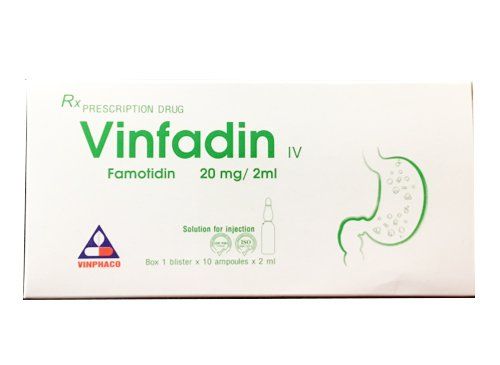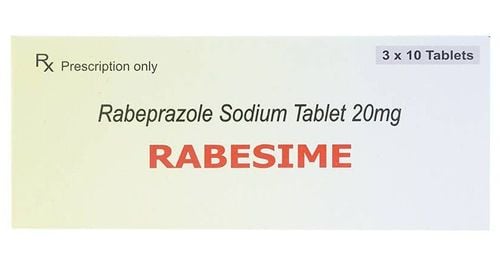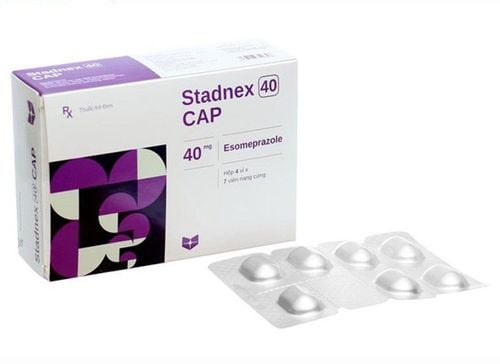This is an automatically translated article.
Ulsotac belongs to the list of gastrointestinal drugs, the dosage form of enteric coated tablets. Adhering to indications, the dose of Ulsotac will help patients improve treatment effectiveness and avoid unwanted side effects.
1. Indications of the drug Ulsotac
Ulsotac medicine contains the main ingredient is Pantoprazole (in the form of pantoprazole sodium sesquihydrate) 40mg, packing box of 10 blisters x 10 tablets.
Pharmacodynamics:
The active ingredient Pantoprazol in Ulsotac is a proton pump inhibitor, which inhibits the final stage of acid formation in the stomach by covalently binding to the enzyme system (H+, K+)-ATPase at the surface. secretory surface of gastric parietal cells. This mechanism leads to inhibition of both conventional and stimulant gastric acid secretion mechanisms. Binding to the (H+, K+)-ATPase system results in an anti-acid effect lasting more than 24 hours for all doses tested. Pharmacokinetics:
Peak plasma concentrations of pantoprazole are reached about 2-2.5 hours after oral administration. Approximately 98% of pantoprazole is bound to plasma proteins. Ulsotac is extensively metabolised in the liver, mainly via the cytochrome P450 isoenzyme CYP2C19, to desmethylpantoprazol. Small amounts are also metabolised by CYP3A4, CYP2D6 and CYP2C9. The metabolites are eliminated mainly (about 80%) in the urine, with the remainder being excreted in the bile. The terminal half-life is about 1 hour, longer in patients with hepatic impairment, about 3-6 hours in patients with cirrhosis. Ulsotac is indicated for the treatment of the following conditions:
Gastroesophageal reflux disease (GERD). Prevention of ulcers caused by non-steroidal anti-inflammatory drugs. Gastrointestinal ulcers. Pathological hypersecretory state (Zollinger-Ellison syndrome).
2. Contraindications of Ulsotac
Ulsotac is contraindicated in the following cases:
Patients with hypersensitivity to pantoprazol, other benzimidazole derivatives (such as Esomeprazol, Omeprazol, Lansoprazole and Rabeprazol) or any of its ingredients.
3. Dosage and how to take Ulsotac
Dosage:
Treatment of gastroesophageal reflux syndrome (GERD):
Recommended dose of Ulsotac: Take 20-40mg / time / day, for 4 weeks, can last up to 8 weeks. Ulsotac Maintenance Dose: Take 20-40 mg daily. In case of relapse: 20mg/day. Treatment of peptic ulcers:
Recommended dose of Ulsotac: Take 40mg/time/day. Duration of treatment is 2-4 weeks for duodenal ulcer disease and 4-8 weeks for benign gastric ulcer. Prevention of ulcers caused by non-steroidal anti-inflammatory drugs:
Recommended dose of Ulsotac: Take 20mg/day. Treatment of Zollinger - Ellison syndrome:
Initial dose of Ulsotac: Take 80mg/day. Patients can take doses up to 240mg/day. If taking more than 80mg/day, it should be divided into 2 times. For patients with liver and kidney failure, it is necessary to consult a doctor for an appropriate dose.
Note: The above Ulsotac dosage is for reference only. The specific dose of Ulsotac depends on the condition and the progression of the disease. To get the right dose of Ulsotac, patients should consult their doctor or healthcare professional.
How to use: Ulsotac is taken orally. Ulsotac tablets should be swallowed whole by the patient. Chewing, breaking, or crushing Ulsotac can increase side effects when taken.
4. Ulsotac drug interactions
Although pantoprazole is extensively metabolized in the liver, primarily by cytochrome P-450 (CYP) isoenzyme 2C19, and to a lesser extent by isoenzymes CYP3A4, CYP2D6 and CYP2C9, clinical trials have shown no significant interactions. clinically important relationship between Ulsotac and other drugs metabolised by the same isoenzyme. Ulsotac has a pH-dependent gastric absorption: Theoretically, the possibility of a pharmacokinetic interaction when pantoprazole is co-administered with drugs with a pH-dependent gastric absorption (eg, ampicillin ester, iron salts) , ketoconazole) will increase or decrease the absorption of Ulsotac with increasing gastric pH. Ulsotac has the potential to increase INR and prothrombin time when warfarin is co-administered with proton pump inhibitors, including pantoprazole. Risk of abnormal bleeding and death. Therefore, an increase in INR should be monitored when Ulsotac is co-administered with Warfarin. In addition, Ulsotac may slow the absorption and decrease bioavailability of proton pump inhibitors (such as lansoprazole and omeprazole). If a combination is required, a proton pump inhibitor should be taken at least 30 minutes before taking Ulsotac. To avoid interactions, before being prescribed Ulsotac, patients should inform their doctors about all the drugs they are using, including dietary supplements. The doctor will base on that to prescribe the appropriate Ulsotac.
5. Ulsotac side effects
In general, Ulsotac is well tolerated even with short-term and long-term treatment. However, if using Ulsotac, patients may also experience some unwanted effects such as:
Common: Headache, fatigue, skin rash, muscle pain, urticaria and joint pain. Uncommon: Dizziness, asthenia, dizziness, pruritus and increased liver enzymes. Rare: malaise, diaphoresis, peripheral edema, anaphylaxis, maculopapular rash, alopecia, hepatic encephalopathy, acne, hepatitis, jaundice, hyponatremia, stomatitis, gastrointestinal disturbances, hypertriglyceridemia, exfoliative dermatitis, erythema multiforme, angioedema, belching, blurred vision, insomnia, inhibition, agitation, photophobia, somnolence, tinnitus, urination blood, interstitial nephritis, hallucinations, impotence, confusion, tremor, eosinophilia, paresthesia, leukopenia, thrombocytopenia, and agranulocytosis. If you experience these symptoms, the patient should stop using Ulsotac and notify the doctor for appropriate treatment.
6. Precautions when using Ulsotac
Patients may experience a slight and transient increase in serum ALT (SGPT) during treatment with oral Ulsotac. The safety and effectiveness of Ulsotac in children under 18 years of age have not been established. Long-term (>1 year) use of Ulsotac may slightly increase the risk of hip, spine, and wrist fractures. This condition mainly occurs in the elderly or in the presence of other risk factors. Patients at risk of osteoporosis should be cared for according to current clinical guidelines and should be adequately supplemented with vitamin D and calcium during treatment with Ulsotac. Ulsotac can increase the risk of fracture by 10 to 40%. It is advisable to measure magnesium levels before initiating therapy and periodically during treatment in patients requiring long-term treatment with Ulsotac or concurrently taking Ulsotac with Digoxin or other hypomagnesaemic agents. There are no adequate and well-controlled studies of Ulsotac in pregnant women. Therefore, women who are pregnant should not take Ulsotac. Ulsotac is distributed in breast milk. Therefore, it is necessary to discontinue nursing or discontinue Ulsotac due to the potential risk to the nursing infant. The possibility of a malignant peptic ulcer should be excluded before administration of Ulsotac because pantoprazol may mask symptoms and delay diagnosis. Ulsotac can cause side effects such as dizziness and visual disturbances. If these side effects occur, the patient should not drive or operate machinery. Absolutely do not use when Ulsotac has signs of discoloration, mold, watery or expired. Above is all information about Ulsotac, patients need to carefully read the instructions for use, consult a doctor / pharmacist before using. Absolutely do not arbitrarily buy Ulsotac to treat at home because there may be unwanted side effects.
Please dial HOTLINE for more information or register for an appointment HERE. Download MyVinmec app to make appointments faster and to manage your bookings easily.













